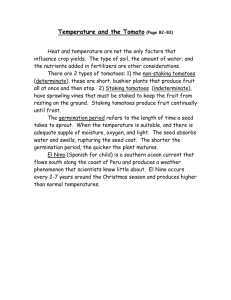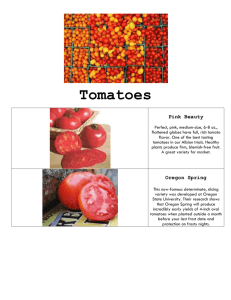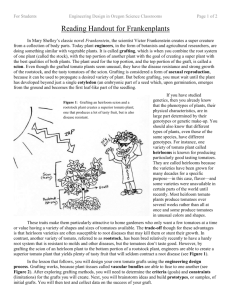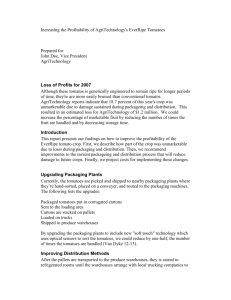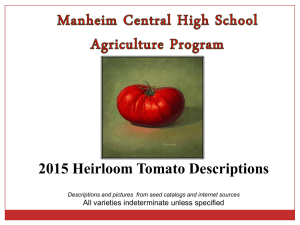HEIRLOOM TOMATOES
advertisement
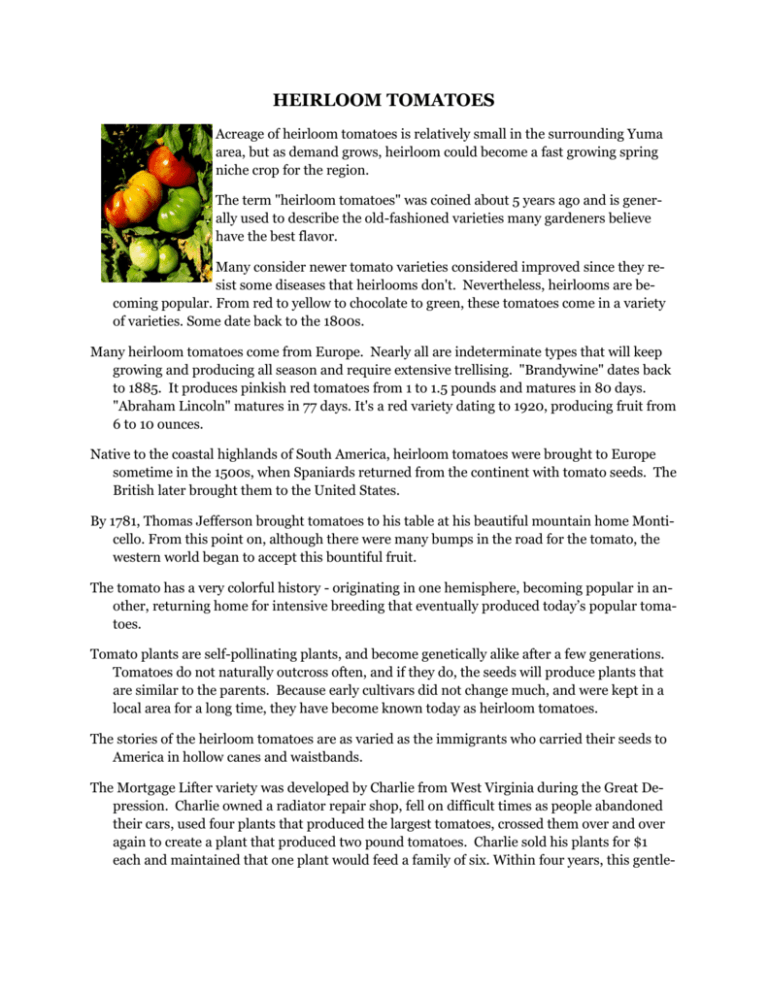
HEIRLOOM TOMATOES Acreage of heirloom tomatoes is relatively small in the surrounding Yuma area, but as demand grows, heirloom could become a fast growing spring niche crop for the region. The term "heirloom tomatoes" was coined about 5 years ago and is generally used to describe the old-fashioned varieties many gardeners believe have the best flavor. Many consider newer tomato varieties considered improved since they resist some diseases that heirlooms don't. Nevertheless, heirlooms are becoming popular. From red to yellow to chocolate to green, these tomatoes come in a variety of varieties. Some date back to the 1800s. Many heirloom tomatoes come from Europe. Nearly all are indeterminate types that will keep growing and producing all season and require extensive trellising. "Brandywine" dates back to 1885. It produces pinkish red tomatoes from 1 to 1.5 pounds and matures in 80 days. "Abraham Lincoln" matures in 77 days. It's a red variety dating to 1920, producing fruit from 6 to 10 ounces. Native to the coastal highlands of South America, heirloom tomatoes were brought to Europe sometime in the 1500s, when Spaniards returned from the continent with tomato seeds. The British later brought them to the United States. By 1781, Thomas Jefferson brought tomatoes to his table at his beautiful mountain home Monticello. From this point on, although there were many bumps in the road for the tomato, the western world began to accept this bountiful fruit. The tomato has a very colorful history - originating in one hemisphere, becoming popular in another, returning home for intensive breeding that eventually produced today’s popular tomatoes. Tomato plants are self-pollinating plants, and become genetically alike after a few generations. Tomatoes do not naturally outcross often, and if they do, the seeds will produce plants that are similar to the parents. Because early cultivars did not change much, and were kept in a local area for a long time, they have become known today as heirloom tomatoes. The stories of the heirloom tomatoes are as varied as the immigrants who carried their seeds to America in hollow canes and waistbands. The Mortgage Lifter variety was developed by Charlie from West Virginia during the Great Depression. Charlie owned a radiator repair shop, fell on difficult times as people abandoned their cars, used four plants that produced the largest tomatoes, crossed them over and over again to create a plant that produced two pound tomatoes. Charlie sold his plants for $1 each and maintained that one plant would feed a family of six. Within four years, this gentle- man from West Virginia made enough money with his Mortgage Lifter tomato to pay off the $6,000 mortgage on his home! To be considered an heirloom tomato, the variety must have been grown for at least 50 years, must be stable and able to reproduce itself, and have a known history regarding area of origin, people who used the tomato or outstanding qualities Heirloom tomatoes date back hundreds of years, and are becoming the most popular of all tomatoes due to their fabulous flavor - low acid and high acid fruit - colors, shapes and culinary applications. Heirloom tomatoes are available in black, dark purple, green striped, yellow and green striped, red, orange, yellow, green, red and black, colors of the rainbow. The shapes of heirloom tomatoes are wide- ranging - like peppers, small like cherries, some weighing in at 5+ pounds, rough-edged, smooth skin, oval, round - and quite visually appealing. There are at least 10,000 varieties of tomatoes (from the small marble sized cherry to the Ponderosa, which can weigh over three pounds). The jelly-like substance around the seeds contains the highest concentration of vitamin C. The smallest tomato species are less than three-quarters of an inch in diameter. There are yellow and red varieties. Botanically, tomatoes are actually a fruit. This is because, generally, a fruit is the edible part of the seed containing the seeds, while a vegetable is the edible stems, leaves, and plant roots. But in 1863 the Supreme Court ruled that tomatoes were to be considered vegetables. The tomato is the world's most popular "fruit"; more than 60 million tons are produced each year. This is 16 million more tons than the banana, the second most popular. The third most popular are apples (36 million), then oranges (34 million), and watermelons (22 million). The early American colonists regarded the tomato as poison because it's related to the deadly nightshade plant (but so is the potato!). Colonel Robert Gibbon Johnson stood on the steps of the Salem, New Jersey courthouse in 1820 and ate a tomato-and then a few more-without any adverse effects, to the town's amazement. The largest tomato ever grown (to date) was seven pounds, twelve ounces. If you suffer from a skin disease, a tomato a day may keep the doctor away. Tomatine, tomato's principle alkaloid, heals certain fungus disorders (green tomatoes contain large amounts of this, but don't eat them raw. Cook (including fried!) or pickle them first. Lycopene is the substance that gives tomatoes their rich red color. It's also an antioxidant that reduces the risk for prostate cancer in men and helps reduce heart disease. One tomato plant can produce 15 tomatoes in a season. Tomatoes vary in size from the tiny South American currant (both red and yellow) tomatoes where several will fit into a teaspoon to the Delicious variety, which holds many state records for size and the world record as well. It commonly weighs over three pounds and has come close to eight pounds which is the world record. As mentioned earlier, many people who have had limited experience with tomatoes think that tomatoes only come in one color-red. To the surprise of many, tomatoes come in a multitude of colors with red being the most common in this country. Other colors are pink, brown, black, orange, purple, white, green (even when ripe), and various striped varieties with the red-striped Yellow German variety being the most common striped tomato. And all of the above colors come in varying hues. Most people think that tomatoes arrived on the earth in the familiar round shape. They are then surprised to discover that they are oblong, flat with ribs, heart shaped, ruffled, pepper like (and hollow just like peppers), and many combinations of shapes. While most plant breeders have tried to make them rounder and rounder and more uniform in shape, other breeders have tried to make them square so that they will fit into boxes more easily. Suffice to say, most large heirloom varieties do not come in uniform shapes and sizes, which is one of the reasons they do not ship well. As tomatoes sold commercially have had to travel greater and greater distances, plant breeders have bred them to be hard fruits, most of which are picked green, then transported. On the other hand, the green (when ripe), black, brown, purple, and white varieties are the softest of all and will not tolerate being shipped when ripe. With them it is best to leave them on a flat surface stacked only one level high and then eat them within three days of picking. People who care the most about tomato flavor tend to like the softer varieties and know just when to serve them, based more on how they feel to the touch rather than how they look to the eye. Many customers want a tomato that "bites them back when they bite it"-or, in other words, a very acid tomato. Most are disappointed with commercial varieties because their flavor is so bland, but that is the characteristic of any tomato picked green and then later gassed for ripening. Their flavors never develop. All tomatoes ripened on the vine have a substantial amount of acid, but they vary greatly in the proportion of sugars. As a general rule, red tomatoes are the most acid of the various colors while yellows are the sweetest. The pinks, blacks, browns, purples, greens, whites and striped all have varying acid/ sugar combinations with the Yellow German tomatoes (yellow with red stripes) being the most sweet of all I know about. Flavor scientists have isolated over thirty flavor components of tomatoes and there are probably many more. The flavors change as the season progresses from early summer to fall with most varieties becoming more acid as the season progresses, probably a combination of shorter days, cooler nights, and the general loss of foliage to disease and weathering as the season progresses. A diminished amount of total leaf surface means less space for the production of sugars. At any rate, those who wish to can tomatoes and have a high acid content in the finished product would be wise to can from about the middle of August onward. Kurt Nolte is an area agriculture agent with the Yuma County Cooperative Extension. He can be reached at 928-726-3904.
